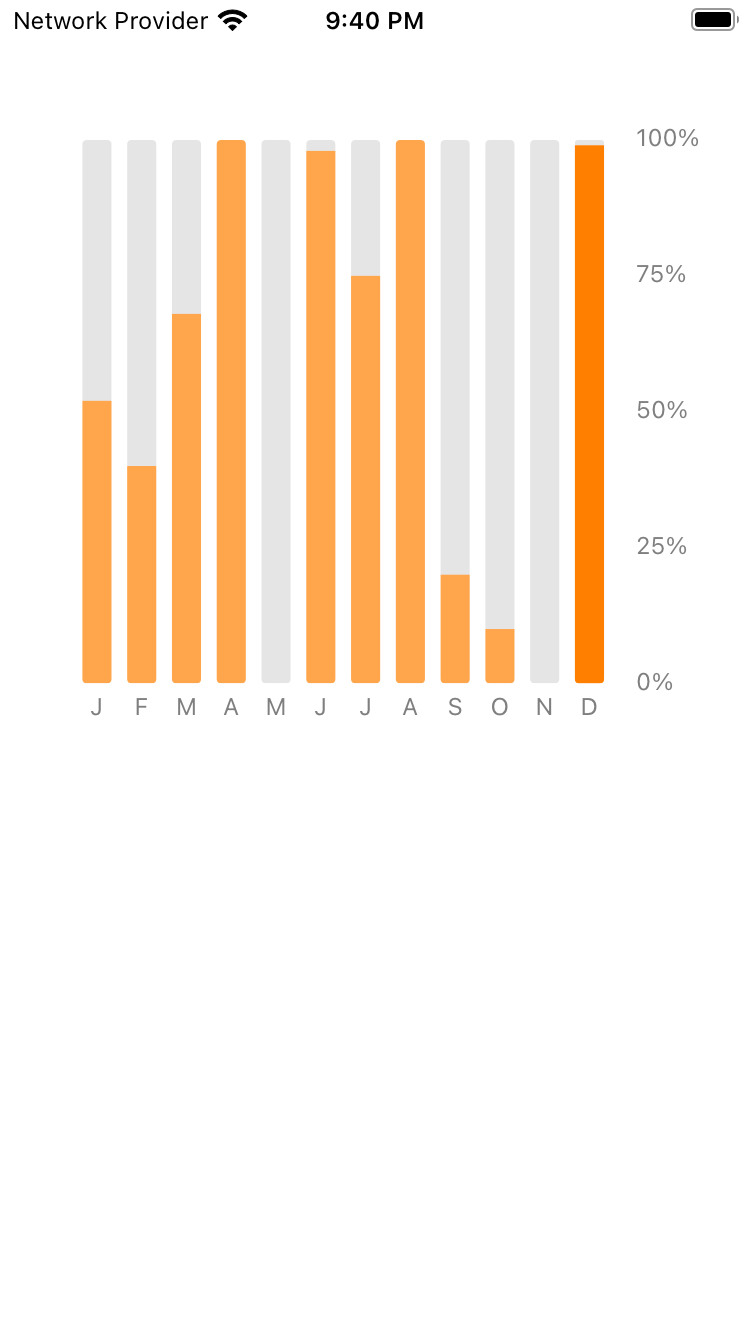Stacked Bar Chart with Corner Radius Renderer
After receiving a UX design not supported by Library, for which intially raised a PR
but eventually succeeded to customize so decided to write an post for same to help someone avoid same problems.
In this post we will look into creating a corner-radius renderer for stacked bar chart.
(Refer Final Result for screenshot after using corner-radius renderer). Assuming you have already installed
Charts Library by adding to Podfile of your project and imported Charts to required UIViewController.
Final Result :

Let’s start by creating required months and associated values.
let months = ["J","F","M","A","M","J","J","A","S","O","N","D"]
let percentages = [52.0, 40.0, 68.0, 100.0, 0.0, 98.0, 75.0, 100.0, 20.0, 10.0, 0.0, 99.0]
Next we need to create and connect IBOutlet of barChartView.
Now, create setupVerticalChart() method to define required graph Configurations/Settings (they are self-explanatory):
func setupVerticalChart() {
// Graph Position
barChartView.extraLeftOffset = 0
barChartView.extraTopOffset = 0
barChartView.extraBottomOffset = 0
barChartView.extraRightOffset = 0
let xAxis = barChartView.xAxis
let rightAxis = barChartView.rightAxis
barChartView.leftAxis.enabled = false
xAxis.labelPosition = .bottom
barChartView.legend.enabled = false
barChartView.drawGridBackgroundEnabled = false
xAxis.granularity = 1.0
xAxis.labelCount = 12
barChartView.pinchZoomEnabled = false
barChartView.doubleTapToZoomEnabled = false
barChartView.backgroundColor = .white
// Graph X Axis and Right Axis Color
xAxis.axisLineColor = .clear//UIColor.black.withAlphaComponent(0.2)
xAxis.gridColor = .clear//UIColor.black.withAlphaComponent(0.2)
xAxis.labelTextColor = UIColor.black.withAlphaComponent(0.5)
rightAxis.gridColor = .clear//UIColor.black.withAlphaComponent(0.2)
rightAxis.axisLineColor = .clear//UIColor.black.withAlphaComponent(0.2)
rightAxis.labelTextColor = UIColor.black.withAlphaComponent(0.5)
// Graph X Axis and Right Axis Font
rightAxis.labelFont = UIFont.systemFont(ofSize: 12)
xAxis.labelFont = UIFont.systemFont(ofSize: 12)
rightAxis.drawZeroLineEnabled = false
rightAxis.drawAxisLineEnabled = false
barChartView.delegate = self
}
We need to create 2 helper method dataSetWith() to create BarChartDataSet and setupRightAxisFormatter for formatting values with “%” suffix:
func setupRightAxisFormatter() {
let rightAxisFormatter = NumberFormatter()
rightAxisFormatter.positiveSuffix = "%"
let rightAxis = barChartView.rightAxis
rightAxis.valueFormatter = DefaultAxisValueFormatter(formatter: rightAxisFormatter)
rightAxis.axisMinimum = 0
rightAxis.axisMaximum = 100
rightAxis.granularity = 25
}
func dataSetWith(entries: [BarChartDataEntry],
colors: [UIColor] = [.black],
highlightColor: UIColor,
label: String = "") -> BarChartDataSet {
let barDataSet = BarChartDataSet(entries: entries, label: label)
barDataSet.drawIconsEnabled = false
barDataSet.drawValuesEnabled = false
barDataSet.colors = colors
barDataSet.highlightColor = highlightColor
barDataSet.highlightAlpha = 1.0
barDataSet.highlightLineWidth = 0
return barDataSet
}
Now we are ready to update Chart data for 12 months with respective values of each month.
Since we are working with Stacked bar chart, we need to calculate 2 values i.e. val1 & val2
wherein val1 is value depicted by orange color & val2 with light gray color.
After creating BarChartData from BarChartDataSet we notify ChartView of dataSet modification with barChartView.notifyDataSetChanged():
func setupData() {
var barEntries = [BarChartDataEntry]()
for interval in 0..<months.count {
let val1 = Double(percentages[interval])
let val2 = 100 - val1
barEntries.append(BarChartDataEntry(x: Double(interval), yValues: [val1, val2]))
}
let barDataSet = dataSetWith(entries: barEntries,
colors: [UIColor.orange.withAlphaComponent(0.7), UIColor.black.withAlphaComponent(0.1)],
highlightColor: UIColor.orange.withAlphaComponent(1.0),
label: "label")
barChartView.xAxis.valueFormatter = IndexAxisValueFormatter(values: months)
setupRightAxisFormatter()
let barData = BarChartData(dataSet: barDataSet)
barData.barWidth = 0.65
barDataSet.barBorderWidth = 0.5
barDataSet.barBorderColor = UIColor.black.withAlphaComponent(0.1)
barChartView.data = barData
barChartView.fitBars = true
barDataSet.axisDependency = .right
barChartView.notifyDataSetChanged()
}
Finally, Update viewDidLoad() method by adding setupVerticalChart() & setupData()
so that on intialisation itself Bar chart is first configured with required settings & then loaded with data :
override func viewDidLoad() {
super.viewDidLoad()
// Do any additional setup after loading the view.
setupVerticalChart()
setupData()
}
Inorder to create CornerRadiusStackBarRenderer we need to first jump to the definition of BarChartRenderer
for initBuffers, prepareBuffer, drawDataSet & drawHighlighted methods.
Next create a new class of CornerRadiusStackBarRenderer which inherits from BarChartRenderer so we can override the behaviour as per our needs.
Create setupCorner() method and update drawDataSet, drawHighlighted methods to set up corner-radius : -
func setupCorner(context:CGContext, dataSet: IBarChartDataSet, index: Int, stackIndex:Int, barRect:CGRect) {
if let currentEntry = dataSet.entryForIndex(index) as? BarChartDataEntry {
let bezierPath = UIBezierPath(roundedRect: barRect, byRoundingCorners: [.allCorners], cornerRadii: CGSize(width: cornerRadius, height: cornerRadius))
if currentEntry.yValues![stackIndex] == 0 || currentEntry.yValues![stackIndex] == 100 {
let roundedPath = bezierPath.cgPath
context.addPath(roundedPath)
context.fillPath()
}
else {
if stackIndex == 0 {
let bezierPath = UIBezierPath(roundedRect: barRect, byRoundingCorners: [.bottomLeft, .bottomRight], cornerRadii: CGSize(width: cornerRadius, height: cornerRadius))
let roundedPath = bezierPath.cgPath
context.addPath(roundedPath)
context.fillPath()
}
else {
let bezierPath = UIBezierPath(roundedRect: barRect, byRoundingCorners: [.topLeft, .topRight], cornerRadii: CGSize(width: cornerRadius, height: cornerRadius))
let roundedPath = bezierPath.cgPath
context.addPath(roundedPath)
context.fillPath()
}
}
}
}
Update setupVerticalChart() method inorder to start using the corner-radius renderer.
barChartView.renderer = CornerRadiusStackBarRenderer(dataProvider: barChartView,
animator: barChartView.chartAnimator,
viewPortHandler: barChartView.viewPortHandler)
Hope above post was informative and useful. You can check the source code on github : HERE